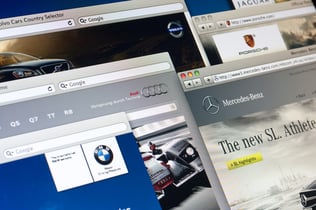 “Dealers need to provide customers with a consistent, relevant, seamless experience throughout each stage of purchasing, including the dealership website.” – David Boice
“Dealers need to provide customers with a consistent, relevant, seamless experience throughout each stage of purchasing, including the dealership website.” – David Boice
Recently, I attended a webinar given by David Boice, CEO and founder of a company called Advid. It was titled, “Lessons from Amazon Prime: evolving the consumer experience in the digital era.” I thought Mr. Boice had some important things to say about what consumers think and feel when they start their search for a new car, and I wanted to share this with our readers. To understand his message, we have to start at the beginning of the consumer buying experience.
The Eight Steps of a Sale
Cox Automotive came up with a flow chart covering what they see as the eight steps of the sale:
- Informed Salesperson
- Compare Vehicles & Payments in Store
- Test Drive
- Trade-in Appraisal
- Negotiate Deal Terms
- Finalize Vehicle Finance
- Evaluate & Purchase Add-on Products
- Delivery & Vehicle Orientation
If you are in the business of selling cars, you should take time to understand these, because, as Cox says, “In most cases, you won’t see many visual cues, yet more and more, we’re finding that these emotions are what  drive purchase decisions or cause shoppers to leave before the sale.” The main takeaway is that dealers need to adjust their strategies and processes to promote positive emotions.
drive purchase decisions or cause shoppers to leave before the sale.” The main takeaway is that dealers need to adjust their strategies and processes to promote positive emotions.
The research, conducted by Root and Associates, found that it is important for dealers to be transparent in providing consumers with information about pricing and payment as early in the process as possible. Consumers do much of their pricing research online across multiple devices. This way, the consumer can feel knowledgeable and more prepared prior to arriving at the dealership. The study showed that in the stage titled “Comparing Vehicles and Payments,” the typical consumer emotion is “confused.”
Here is more data.
- Car buyers spend 59% of their time online, including researching car prices (71%), finding actual cars listed for sale (68%), comparing different models (64%), and locating a dealer or getting dealer information (46%). – Autotrader
- About 22% of internet shoppers use a social media site as a source. – J.D. Power
- The majority of internet shoppers use a mobile device. – J.D. Power
- When researching online, 46% of shoppers use multiple devices. – Autotrader
- About 78% of shoppers use third-party sites. – Autotrader
- When asked about newer car buying alternatives, 54% said they would love to be able to buy a car from home. – 2016 Beepi Consumer Automotive Index
Okay Google
 Google research shows that consumers expect two things when shopping for a new car: speed and relevant content.
Google research shows that consumers expect two things when shopping for a new car: speed and relevant content.
To be relevant to each and every customer, the dealer needs to have a specific ad for each and every new and used car you are selling, not just a “typical” model. Most dealers use a few generic ads that are not specific to an individual car. The consumer finds a listing for exactly the car that they want, and when they go to find more details they are led to a page that is not for that specific vehicle, but for a “typical” generic version. This is frustrating for the consumer because they think they are getting the run-around.
As Google says, “The challenge is to create relevant, data-rich ads for every vehicle.” It is a challenge because it is time consuming, difficult to scale, and this costs money.” But it has to be done because for a dealer, the biggest marketing priority is increasing lead volume and conversions.
Online Messaging
Boice points out that when this happens, the message is often inconsistent across different mediums. You want to ensure consistency across every marketing touch point. To do this, you have to capture the attention and emotions of the consumer.
Boice says, “Over the last 20 years, car buying has changed drastically, due to significant enhancements in technology, digital advertising, and artificial intelligence and automation. However, while the rest of the world has adapted, automotive websites are behind the times, functioning about the same as 20 years ago and failing the customer experience.”
 Why is this happening? Well, it seems that today over half of car buyers are using multiple devices and resources when they shop for a car. They do not just go to the dealer website.
Why is this happening? Well, it seems that today over half of car buyers are using multiple devices and resources when they shop for a car. They do not just go to the dealer website.
For example, let’s say that the consumer has already purchased a car from you, and you have all their personal information because they are in your database. The consumer goes to your website and is asked to sign in and fill out a form. Their reaction is, “Why do I have to fill out a form to give you information you already have about me? I am already your customer!”
As a dealer, you have to differentiate between your existing customers and the general public. The customer should get a message that says, “We know your name and we know who you are. We know what you bought from us and what it is worth now. We can give you the trade-in value before you come in. We have the recall information on your car too, and your service history.”
This is a personalized experience.
Boice calls it the ‘Amazon Prime like’ experience.
Now, the customer feels they are in the right place, so they do not really need to go to any other dealer. You can now give them custom offers that personalize their experience based on your database. You can streamline the online purchasing experience. You can optimize the in-store and online experiences with unique and relevant experiences that are tailored to each consumer.
A study by DMEautomotive showed that integrated mobile apps and connected vehicle services deliver more value for the customer, enhancing customer loyalty after the initial purchase. Buyers using a branded app were 73% more likely to make a purchase from the dealership, and after making the purchase, booked 25% more service appointments than shoppers without an app!
The lessons are pretty clear here. These connected systems are important to the younger, more digitally oriented consumers, but other buyers as well. Dealers must pay attention here.
The Art of the Car Deal
And when it comes to stage five, “Negotiate Deal Terms,” and stage six, “Finalize Vehicle Finance,” the typical consumer emotion is either “anxious,” “fearful,” or “confused.”
 This is where CrossCheck can really help. Dealers will always prefer to take a check, particularly for a high-dollar payment, rather than take a credit card and pay a 3% fee to the issuing bank for something called interchange. CrossCheck guarantees the check so the sale can go through. We give the dealer peace of mind with our Check Guarantee services, but there’s more added value.
This is where CrossCheck can really help. Dealers will always prefer to take a check, particularly for a high-dollar payment, rather than take a credit card and pay a 3% fee to the issuing bank for something called interchange. CrossCheck guarantees the check so the sale can go through. We give the dealer peace of mind with our Check Guarantee services, but there’s more added value.
Sometimes, the buyer has found the car of their dreams, but it is more expensive than they planned. Not to worry, CrossCheck’s Multiple Check program lets the consumer write up to four checks to be deposited over the next 30 days at dates chosen by them, without paying interest.
This typically lets the buyer get the options or add-ons that they want and the car that they want rather than have to choose a cheaper and less desirable car. We give the consumer some breathing room so they have time to get the extra money they need to close the sale. CrossCheck has been doing this for over 36 years and we have backed the sale of hundreds of thousands of cars. We improve the customer experience and get the taillights over the curb. Now, that’s how to promote positive emotions!
Download our free Multiple Check guide and learn how CrossCheck helps auto dealerships increase sales and mitigate risk while saving time and money.


